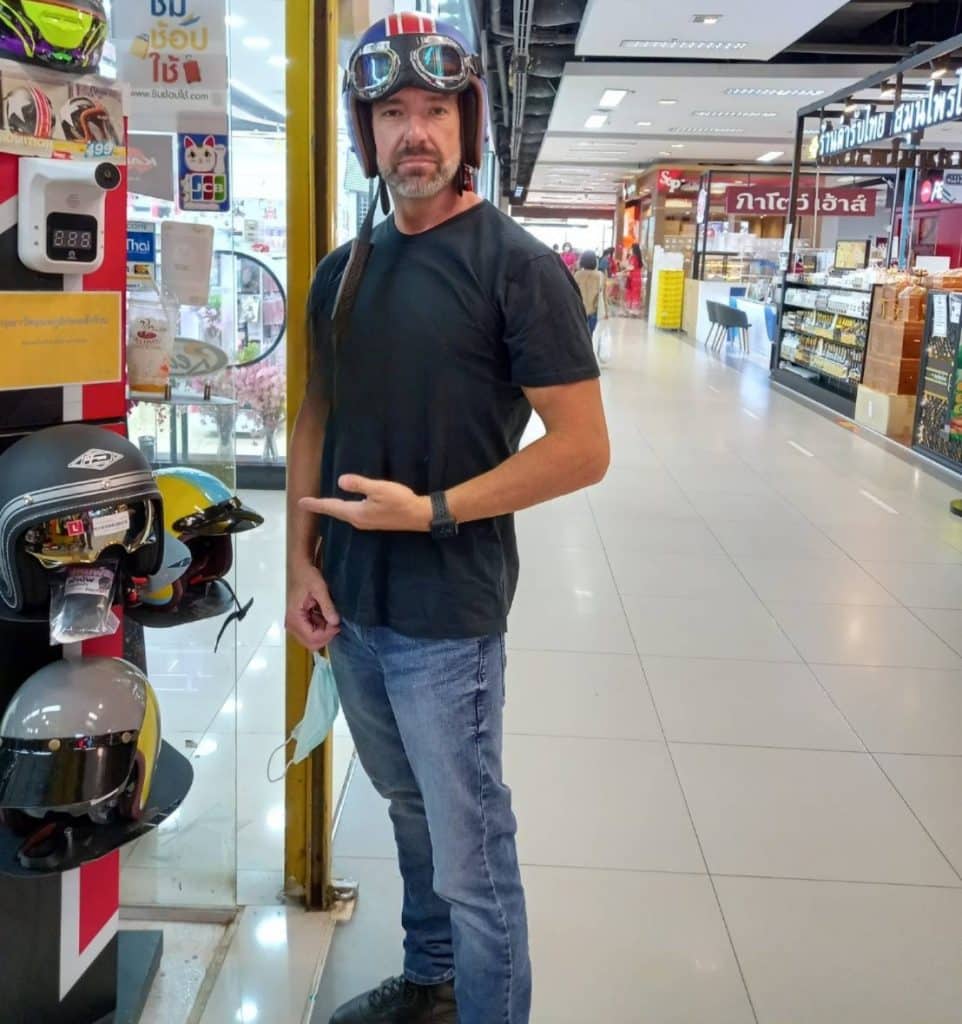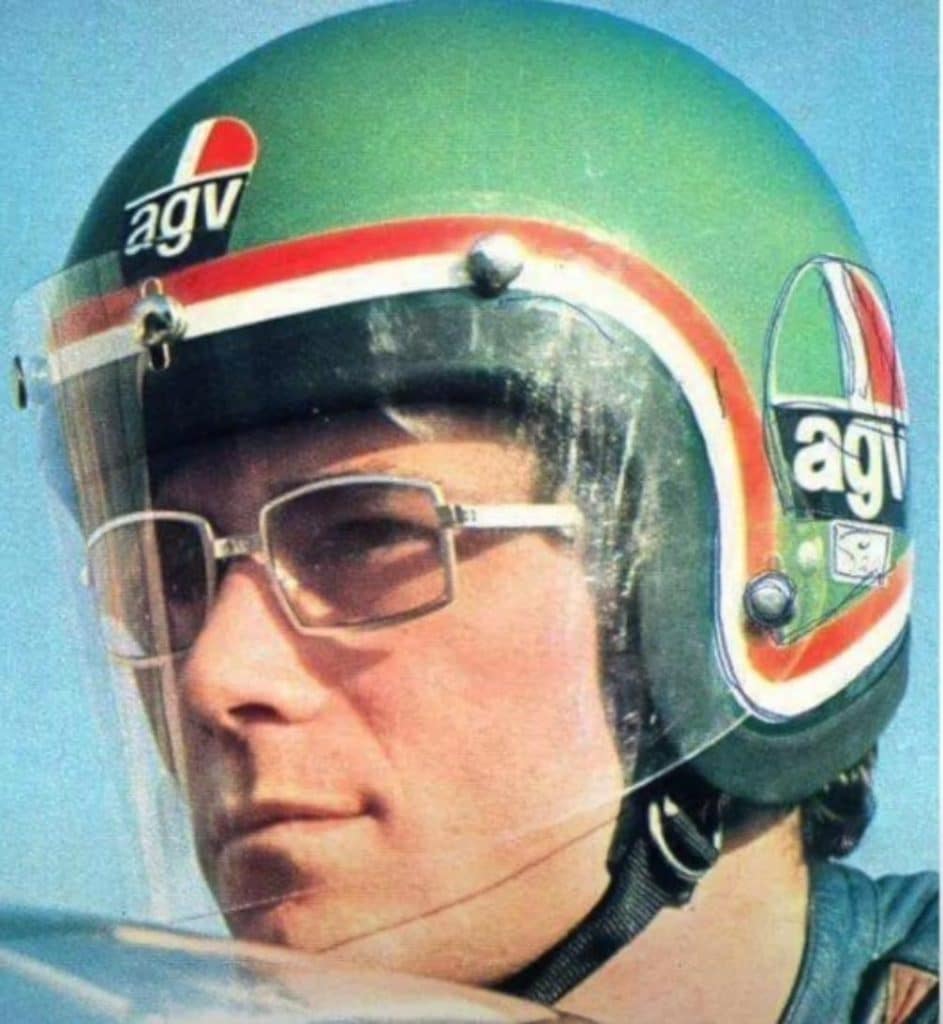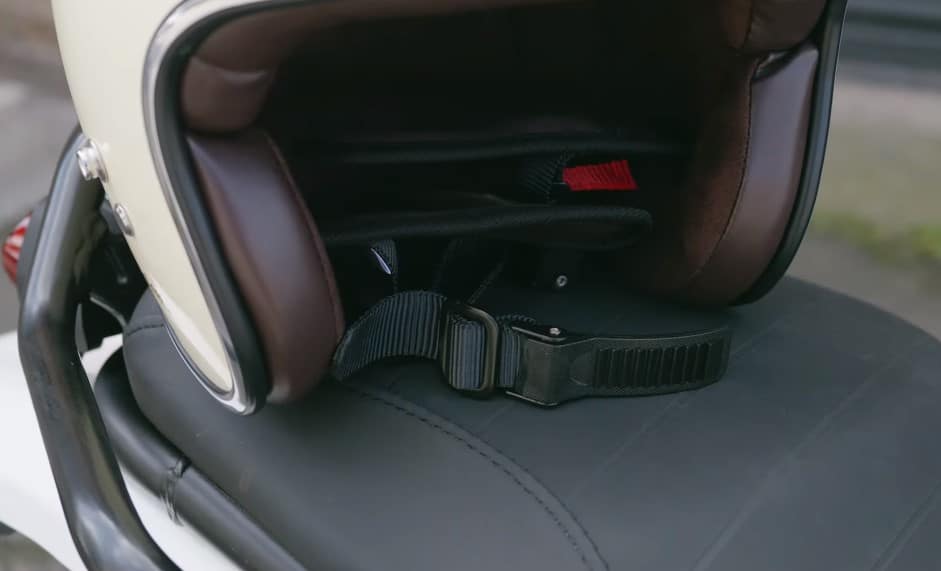Getting the right size for a motorcycle helmet can mean life or death. Comfort and fit also draw the line between a pleasurable and miserable ride. Put simply, correct helmet sizing determines how much protection a helmet can provide in a crash. So much so that a DOT, SNELL, ECE, SHARP, or FIM certification is only varied for the correct helmet shell size and fit for your head. The type of helmet matters, too, and this choice depends on your riding style. Enough to make you wonder — what is the least restrictive helmet?
An open-face (3⁄4) helmet is the least restrictive type, featuring an open front design that allows maximal airflow and 180° frontal vision due to the lack of a chin guard. Its design is optimal for low-speed cruises and short urban commutes, even as a pillion, allowing clear conversations, sipping drinks, or nibbling at your lunch bar (not recommended while riding) without taking your brain bucket off. Do you want to touch your beard or put on some lip balm? You name it!
Top 8 Best Open-Face Motorcycle Helmets Available Today
Even as you scour online or brick-and-mortar stores in your area in pursuit of the best least restrictive motorcycle helmet, take a moment to consider my top picks for the best fit. Scroll right to find buying options, compare prices, and possibly snag exclusive discounts from sellers.
| Helmet Model | Category | Shell Sizes | Check & Shop Now |
|---|---|---|---|
| AGV X70 | Best Overall | 3: XS-MS, ML-LG, XL-2XL | FCMoto | Motardinn | Amazon |
| Bell Custom 500 | Best Classic | 5: XS-SM, MD, LG, XL, 2XL | RevZilla | CycleGear | Amazon |
| Shoei J-Cruise II | Best Cruiser | 3: XS-SM, MD, LG, XL-2XL | RevZilla | Amazon |
| Arai Ram-X | Best Touring | 6: XS, S, M, L, XL, 2XL | RevZilla | Amazon |
| Scorpion EXO Covert X | Best Convertible | 2: XS-L, XL-XXL | RevZilla | Amazon |
9 Solid Reasons To Get an Open-Face Motorcycle Helmet

Freedom is the main reason I would get an open-face helmet for riding. It’s less confining and allows you to ride and do other itty bitty things that would not be possible with a full-face helmet. Don’t even get me started on half helmets – I think those are a joke as far as safety is concerned and should not even be considered for riding unless you just want to look cool.
But I digress, a 1⁄2 helmet is better than 0 helmet. And with a proper three-quarter lid, you can enjoy some decent top and side bang protection with the following additional perks:
1. Tremendous Air flow
It’s the whole point in riding a motorcycle, as opposed to being confined in a moving cage. Feel the wind gently caress your face and hair, reminding you of the true meaning of freedom. It’s akin to riding without a helmet, although illegal in 18 States (and the District of Columbia), and can be a bit lackluster.
Nevertheless, it remains one of the most exhilarating experiences I’ve ever had, especially on open country roads with excellent visibility and speeds not exceeding 50 mph. My point being that open-face helmets are a cheat code to enjoy more airflow to your face and neck while staying compliant.
2. Less Claustrophobic Feel

I’ll be the first to admit, a snug-fitting full-face helmet can sometimes feel like ‘it’s a bit crowded in here,’ a sentiment that doesn’t apply to an open one.
I remember when the legendary “Ago” helmet (AGV X3000) first dropped in 1967, becoming the first full-face helmet in Europe and soon propelling Giacomo Agostini and AGV to world fame. I managed to get my hands on my first one in 1972, but some professional racers like Barry Sheene were still vehemently opposed to the idea of a full-face helmet, citing restricted airflow and vision as safety concerns. Besides, every macho racer should bear some battle scars, right?
But after the out-and-out success of Ago and AGV partnership, and a change in safety regulations for the sport, Sheen changed his mind and even went on to clinch the 1976 and 1977 500cc Motorcycle World Championship titles donning the full-face AGV X3000.
3. Ability To Touch Your Face
If for some reason, you would like to touch up your lips or scratch your beard, etc., while on the bike (I would advise you pull over to address any discomforts), then you can just flick the shield up and do so without taking the helmet off. Whether you are stopped over for a sip of water or shopping for some food on the road, you can access your mouth, and that’s something awesome.
That’s why I would recommend modular helmets as a good compromise between protection and comfort while touring on your motorcycle.
4. Unobstructed Vision

Open-face helmets are, well, open, offering superior views of the motorcycle beneath and the road ahead. The eyeport is unbounded, creating fewer blind spots, resulting in safer riders with better peripheral vision—a requirement by DOT when assessing peripheral vision, with a minimum of 105 degrees allowed from the centerline.
I mean, full-face, modular, off-road, and dual-sport motorcycle helmets have chin bars, which can feel pretty much ‘in your face’ in my experience. Although we love the extra protection for the chin, particularly in dual sport helmets, this usually means you can’t see both the controls and the road ahead simultaneously.
5. No Fogging
Fogging inside the helmet is almost like a folk tale for those who use open face helmets. It’s another reason to prefer the cool fighter pilot vibe of the AGV X70 over the versatility of the Schuberth C5, the quietest modular motorcycle helmet today, boasting a noise reduction percentage of up to 91%, thanks to its acoustic aerodynamics technology.
Although it is still possible for an open face helmet to fog up on the inside, especially with the longer face shield of the new J-Cruise, which notably also includes a Pinlock-ready shield, the fog problem is considerably lessened in open face lids compared to their closed-off counterparts
6. Coherent Conversations

With an open helmet design, you can say goodbye to the muffled, incoherent – sometimes downright awkward – conversations you have with strangers at a stoplight or even your accomplice on the pillion seat while wearing a full-face road helmet. Holding conversations with your pillion and other road users without a motorcycle Bluetooth headset only works at slow speeds!
7. Easier To Put On And Take Off
Comfort and convenience stand as the two primary reasons often cited by those who wear open-face helmets. I concur; achieving a proper fit sometimes brings discomfort, particularly around the ears, when donning or removing a full-face helmet. Open-face helmets, weighing in at 2 to 3 lbs., are also significantly lighter than their full-face counterparts, which typically weigh around 3-4 lbs.
This reduced weight, coupled with their ease of use, makes open-face helmets ideal for quick errand runs, where you might find the need to remove the helmet more frequently.
8. Offer Style And Customization Options

Open face helmets like, say, the Shoei J-Cruise II offer a classic cruiser vibe that compliments the whole motorcycle. Yes, with Harleys, Vespas, and even cafe racers, you kind of have to look the part.
Unfortunately, some cruiser riders want to ride with a bandana headband for an authentic Sons of Anarchy outlaw motorcycle club culture. Again, it’s a bad idea because even chicks no longer appreciate scars, or do they? Let’s at least stick around to find out by wearing a nice protective helmet.
9. Better Protection Than Half and No Helmet
To sum up the benefits, I consider open face helmets a safer option when compared to riding with a half helmet or no helmet at all. The absence of the more stringent ECE, SNELL, or SHARP certifications in half helmets reinforces my perspective, as these safety standards involve comprehensive tests, including face shield/visor penetration, impact, and angled impacts. Unlike half helmets, open face helmets adhere to these rigorous standards, offering better protection. DOT is the basic requirement for all products sold in the United States and Canada, so it holds no substantial ground, in my case!
The new ECE 22.06 rating standard, in particular, assesses visor mechanisms for stability, removability, and impact resistance, including tests with a steel bullet traveling at 60 m/s, as well as impact testing on the top, back, and sides of the helmet—areas left vulnerable by the skull caps. Half helmets lack face shield, sides, and back protection, only covering the top of the head and the area from the forehead to the brows, further emphasizing the reliability of open face helmets in terms of safety.
Moreover, wearing an open face helmet ensures legal compliance in areas where helmet use is mandatory, making it a preferable option over riding without any head protection.
Where Open-Face Helmets Fall Short

Despite the above and numerous more benefits, it is critical that we understand why open-face helmets cannot provide the same level of protection as full-face helmets, even if both are designed to the same shell, EPS, and face-shield specifications.
Well, it’s pretty obvious that ¾ helmets lack any form of a chin guard to protect that area and the face in general during a crash, so you need to balance the risks of reduced face-chin protection and the benefits of airflow, comfort, clear vision, and the pure convenience of open-face lids. But what else is there not to love about these lids? Let’s learn.
1. Reduced Protection For Chin and Face
Open face, you say? More like an exposed face to me, and that, ladies and gents, is why I do not typically wear open-face helmets. Face shields offer an underwhelming defense against the world’s roughest sandpaper in the unfortunate event of a high-side landing headfirst. Don’t get it twisted; any helmet—and I mean any helmet, including the $5 piece of scrap plastic I’ve seen lined up for sale in the streets of Vietnam—is more useful than no helmet at all.
In my experience, open-face lids suffice to keep bugs out of your face and provide a considerable amount of crash protection for shorter commutes, cruises, or even longer, slow-paced touring journeys on the asphalt. You might still need separate eyewear for the Bell Custom 500, which does not come with a face shield, or to protect against dust and bugs that can sneak up under the helmet and enter your eyes.
But if you’ll be riding fast on the street, doing highway speeds, engaging in adventure and off-road riding, or tearing up some dirt, then I recommend getting a specialized lid for your specific riding discipline.
2. Limited Crash Impact Protection

Open-face helmets, compared to their full-face counterparts, offer limited crash mitigation due to their construction. While both styles typically feature retention mechanisms, an equal amount of EPS liner, and layered cheek pads for a snug fit, full-face helmets have an advantage. They can utilize the chin area to create a more secure fit with a narrow neckroll. In contrast, open-face helmets might tend to fall off or twist out of place, increasing the risk of serious head injuries and traumatic brain injuries.
Case in point, FIM only considers full-face helmets with D-ring closure, along with either ECE 22.06 (only “P” type), JIS T 8133:2015 (Type 2 full face), or SNELL M 2015/M 2020D/M 2020R certifications for homologation into the FRHPhe-01 program. ECE tests full-face and flip-up helmets for chin bar rigidity to enhance protection for the lower face area during crashes, speaking further to the inadequacy of 3⁄4 helmets to keep the rider safe in high-speed crashes.
3. Not as Quiet as Full-face Helmets
Yes, the quietness factor of a helmet is relative, but the open construction of the ¾ helmet makes it quite challenging to reduce road and wind noise. Wind easily enters through the unguarded chin area, creating noisy vortices, especially at higher speeds. The sharp edges of the helmet sides also contribute to wind noise, particularly when riding with the massive shield up.
In contrast, the closed, aerodynamic build of the Sena Momentum INC Pro full-face smart helmet, coupled with the immaculate Sena Noise Control Technology, is able to cut down road and wind noise by up to 91%.
4. Less Versatile Than A Full Face Road Helmet
Open-face helmets, like half helmets, are also unsuitable for off-road riding, dirt biking, or racing on the track where highly specialized crash protection covering the chin is mandatory. Furthermore, their poor aerodynamic stability (due to a less streamlined build) can cause discomfort and fatigue in the neck, reducing speed and overall performance. Likewise, the superior ventilation they offer can turn problematic in chilly adverse weather conditions, making them impractical for riding all four seasons.
The limitations extend even to capturing your thrilling journeys. With an open-face helmet, mounting a GoPro is limited to the top and side, excluding the option for chin mounting. I find chin mounting particularly ideal for off-road riding, where I spend a lot of time standing on the pegs. I can also attach a microphone alongside my camera to engage in monologues while recording my adventures.
How To Size And Buy An Open-Face Motorcycle Helmet

Feeling overwhelmed already? Don’t sweat it. I have just the plan to get you the least restrictive helmet that also offers sensible protection for your precious brain. Come with me!
First, Let’s Determine The Size and Shape Of Your Head
It might sound amusing, as we don’t usually know our head size and shape right off the top of our heads (pun intended). But to find the correct helmet size and shape, start by enlisting a friend’s help for accuracy. Have them measure the circumference of your head at its widest point—just above the ears—and you can use either inches or millimeters, as most sizing charts provide both metrics. Keep this measurement as a reference when selecting the appropriate open-face helmet now and in the future.
Understanding your head’s shape is the next step. Have your friend take a picture of your head aiming directly downward while you sit upright. This will help you visualize your head shape as either round, intermediate oval, or long oval. To confirm this, use a soft tape measure to check the horizontal front-to-back and ear-to-ear measurements, noting if they are similar (round), slightly different (intermediate oval), or significantly different (long oval). Pay close attention to the fitment annotations for each helmet you consider, as even helmets from the same brand can vary in fit and head shape suitability.
How Did We Do? Time To Evaluate and Try on Your New Helmet!
Once you have your new helmet, don’t be surprised if it doesn’t slide easily over your head due to a thick neck roll cushion. Helmet linings typically break in about 15% during the initial 20 hours of riding, so they should fit snugly at first. If it’s merely folding your ears, it’s likely the right size. However, if you struggle to put it on, even with considerable outward thumb pressure to spread the base for entry, double-check your measurements and size choice. Conversely, if the helmet feels loose, consider sizing down.
Another useful test involves adjusting the chinstrap to the correct tension and having someone try to remove the helmet by rolling it off back-to-front. If they can do it without discomfort, it might not be the right fit. This method ensures the helmet stays on and moves together with my head, acting as a single mass, to avoid potential impact against my safety gear in the event of a crash.
Lastly, I pay close attention to pressure points. Wearing the helmet for 30 to 45 minutes at home before riding allows me to identify any discomfort, typically around the forehead or temples. If I don’t feel any discomfort, especially at the forehead or temples, then I know we’ve got the fit right!

I've diligently categorized my motorcycle gear recommendations into all available categories, with the aim of providing you with a comprehensive analysis that showcases the absolute best options for all your needs. These items are the culmination of in-depth research, extensive testing, and personal use throughout my vast experience of 50+ years in the world of motorcycling. Besides being a passionate rider, I've held leadership positions and offered consultancy services to reputable companies in over 25 countries. To See Top Picks and the Best Prices & Places to Buy: Click Here! |
FAQs — I Have the Answers!
Q: What Is the Least Restrictive Helmet?
The least restrictive type of motorcycle helmet is the open-face helmet, also known as a three-quarter. Open-face helmets cover the top, sides, and back of the head, leaving the face and chin exposed. Unlike full-face helmets, they lack a front chin guard.
Q: Are Open Face Helmets Worth It?
Yes, open face helmets are worth it as they are not necessarily unsafe, offering more protection than half helmets but less than full-face helmets. If you choose to wear an open-face helmet, be sure to take extra precautions to protect your eyes and face due to their limited coverage.
Q: Are Open Face Helmets Illegal?
No, open face helmets are not illegal, provided they meet the necessary safety standards, including DOT in the United States, ECE in Europe or other standards like Brazil’s NBR 7471, Taiwan’s CNS, Australia’s AS 1698-2006, Japan’s SG or JIS, New Zealand’s NZ 5430, Korea’s KS G 7001, Malaysia’s SIRIM, Thailand’s TIS, India’s IS 4151, and Singapore’s PSB. It’s crucial to ensure compliance with these standards when choosing an open face helmet.
Q: What Is the Safest Type of Helmet?
Full-face helmets are the safest type of motorcycle helmets because they provide full head, face, and chin protection, reducing the risk of injury in case of an accident.
Q: Which Type of Helmet Is Not Allowed?
Novelty helmets, also known as “beanie” helmets, are not allowed for use while riding motorcycles. These helmets do not meet safety standards like DOT, ECE, or SNELL and provide minimal protection. It’s crucial to choose a certified helmet for maximum safety.
Q: What Helmet Offers the Most Protection?
Full-face helmets offer the most protection because they cover the entire head, including the face and chin, providing maximum impact and abrasion protection. They also have a sturdy visor for eye protection, a secure chin strap, and effective impact absorption, minimizing the risk of severe head injuries in a crash.
Q: What Size Helmet Do I Need for a 22-Inch Head?
A 22-inch head circumference might correspond to a size small or medium, but it’s crucial to consult the manufacturer’s sizing chart after measuring your head with a soft measuring tape for accurate information.
Q: How to Determine Head Shape for Motorcycle Helmet?
To determine your head shape for a motorcycle helmet, measure the circumference of your head using a flexible tape measure. Then, measure the length from the forehead to the back of the head and the width from one temple to the other. Compare these measurements to standard head shape charts provided by helmet manufacturers. Alternatively, try on different helmet models to see which one fits snugly and comfortably, aligning with the shape of your head.
Q: Motorcycle Helmet Sizes for Adults
Motorcycle helmet sizes for adults range from small to extra-large, with specific size correspondences based on head circumference provided by the manufacturer. It’s essential to measure your head accurately and consult the manufacturer’s sizing chart for precise sizing information.
Information for this article was partially sourced and researched from the following authoritative government, educational, and non-profit organizations:
- National Institute of Health
- ScienceDirect
- Smarter USA
- United States Department of Transportation (DOT)
- United States Consumer Product Safety Commission
- United States Economic Commission of Europe (ECE)
Ni/A













